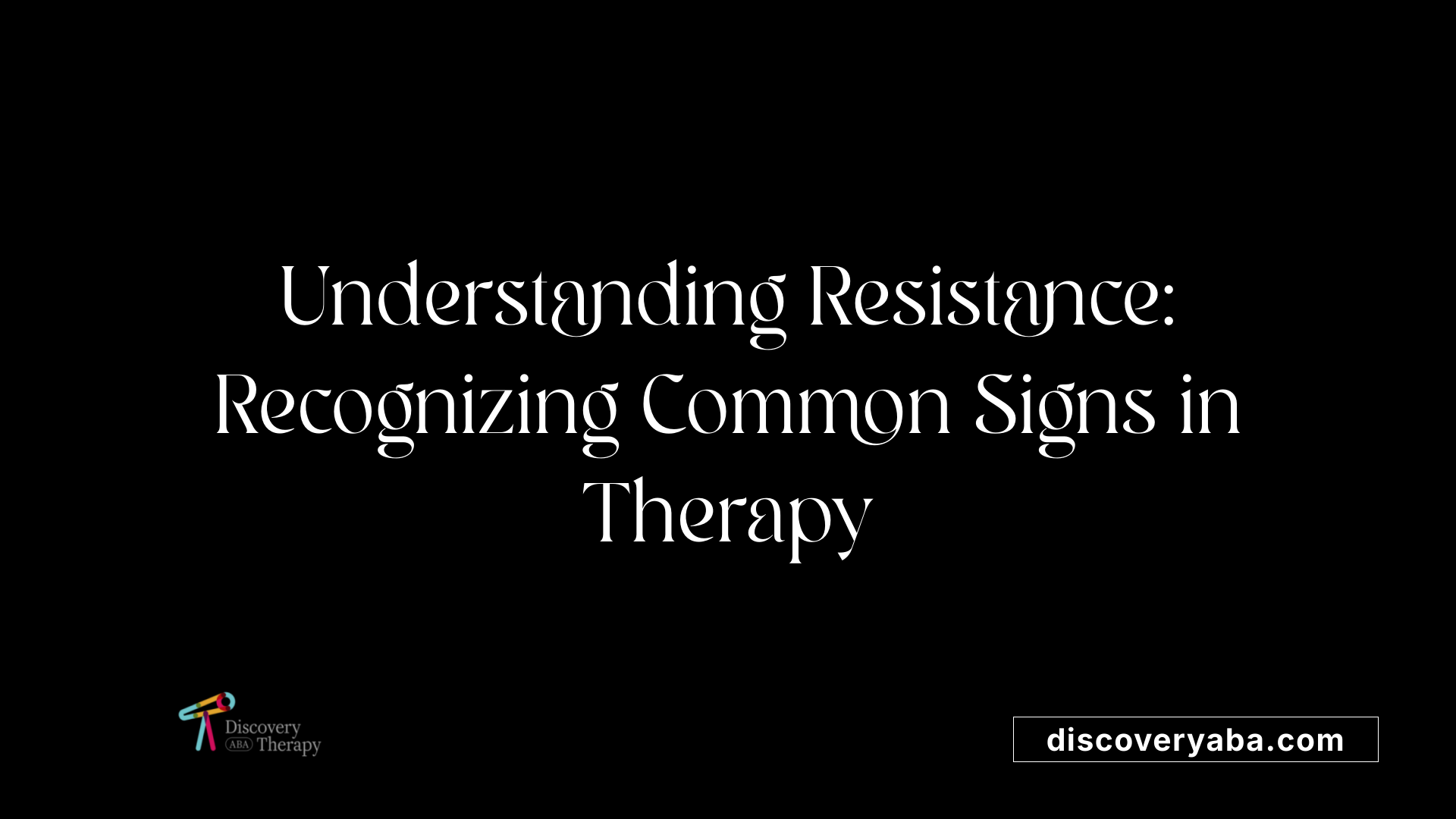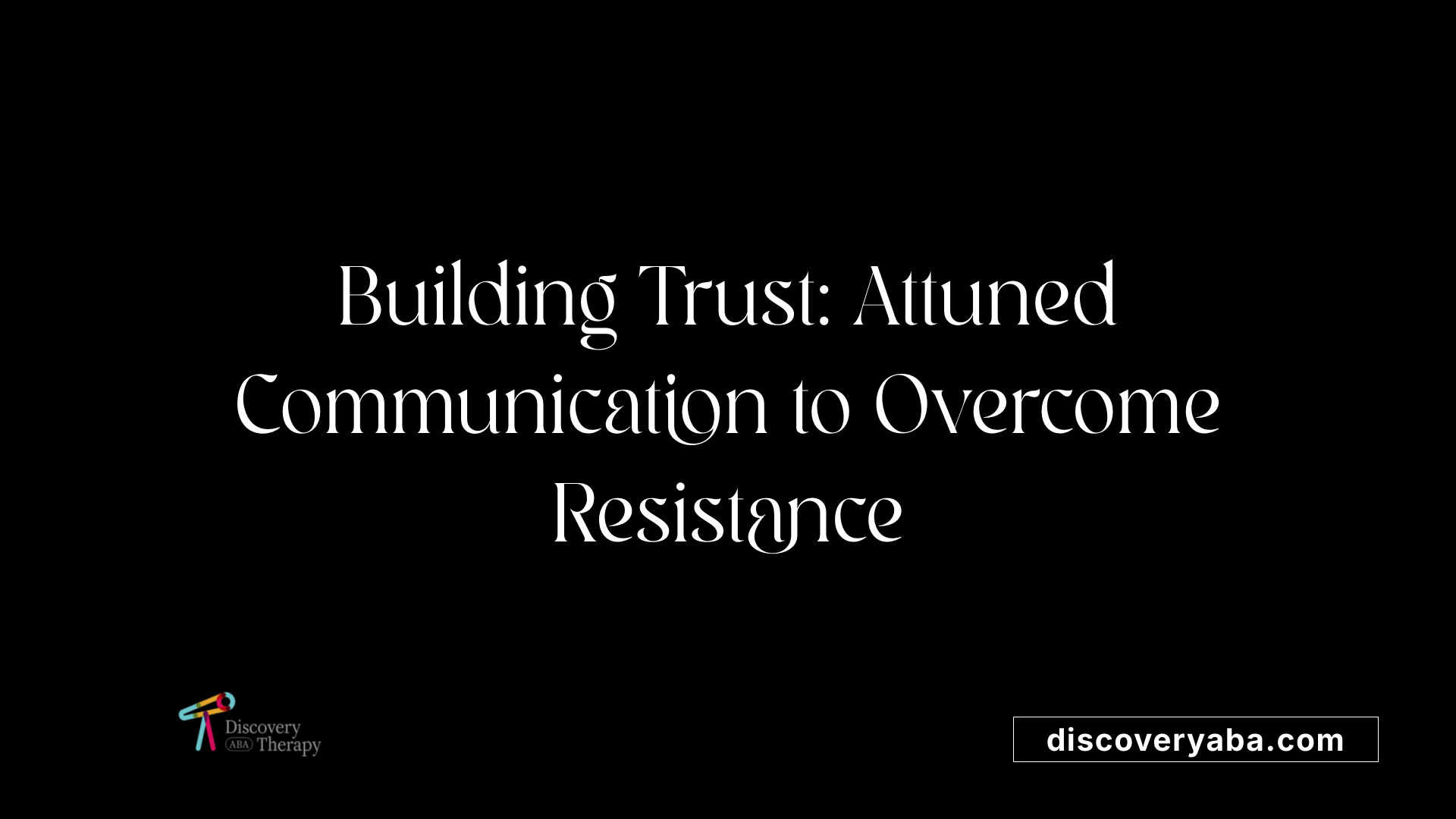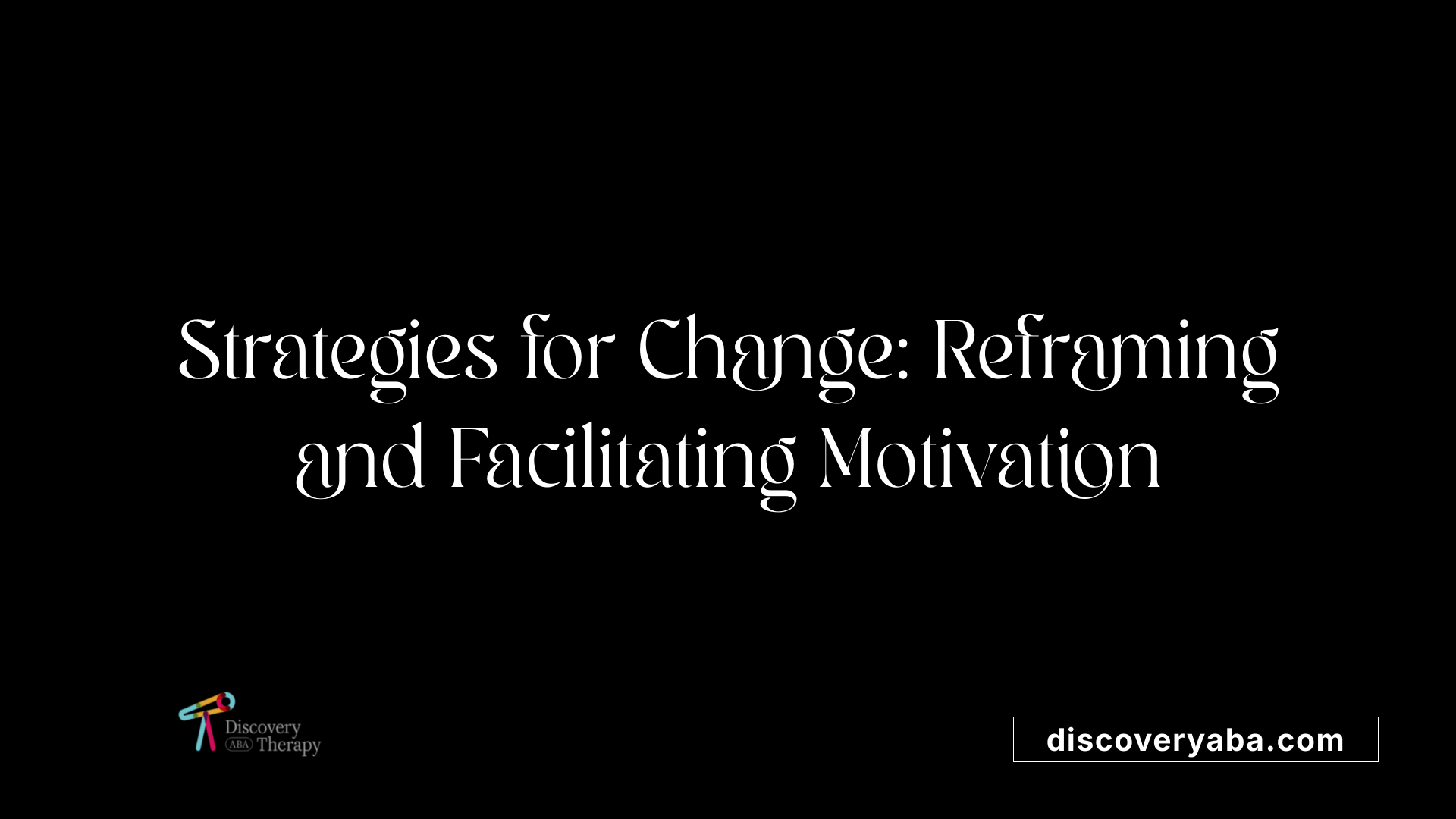Strategies for working through therapy resistance
Overcoming Barriers: Navigating Resistance in Therapy

Understanding and Addressing Therapy Resistance: A Roadmap for Clinicians
Therapy resistance is a common and often misunderstood phenomenon that can challenge even the most skilled clinicians. Recognizing the subtle signs of resistance—from behavioral cues to emotional defenses—is crucial to maintaining a strong therapeutic alliance and fostering meaningful change. This article explores comprehensive strategies for understanding, managing, and overcoming resistance, emphasizing practical approaches rooted in psychological theory, empathy, and collaboration.
Defining Client Resistance and Its Manifestations

What are common examples of client resistance in therapy?
Resistance in therapy manifests in various behaviors and cues, both verbal and non-verbal. Clients often demonstrate resistance through missed appointments or cancellations, which indicate avoidance of addressing difficult issues or reluctance to fully engage in the process. During sessions, some may show minimal participation—failing to do homework tasks or resisting suggested interventions—highlighting non-compliance.
Verbally, resistant clients might argue against the therapist’s approach, deny the presence of problems, or skew conversations away from sensitive topics. They may challenge the therapist’s qualifications or question the necessity of therapy altogether.
Non-verbally, resistance can be seen in body language: sulking, emotional withdrawal, tense postures, or hostility can create a barrier to open communication. Some clients exhibit cynicism or deflectiveness, dismissing the significance of therapy or their own progress.
Additionally, regression into previous behaviors, skepticism about change, or persistent defensiveness are signs that resistance is actively impeding progress. Recognizing these signs allows therapists to adapt their strategies and foster a more collaborative, trusting relationship.
Theoretical Perspectives Explaining Resistance

What are different types of resistance strategies in therapy?
Resistance strategies in therapy refer to the various ways clients may oppose or hinder progress. Common types include avoidance, where clients shy away from difficult topics or change; contesting, where they challenge therapist suggestions or interpretations; and biased processing, where clients interpret information in a way that supports their current beliefs or defenses. Additionally, some clients employ empowerment tactics, resisting by asserting control or independence to maintain their autonomy. These resistance strategies are often motivated by concerns such as fear of losing control, threats to personal freedom, or reluctance to face uncomfortable truths, and understanding them can help therapists tailor their approach to foster cooperation and progress.
How does resistance relate to the psychoanalytic model?
In the psychoanalytic framework, resistance is viewed as an unconscious defense mechanism that the mind employs to prevent the emergence of distressing memories or conflicts. Clients may unconsciously resist by avoiding certain subjects, denying facts, or engaging in intellectualization to sidestep emotional pain. This form of resistance is considered a repressive process; it helps protect the ego from anxiety but also impedes the therapy process by blocking access to unconscious material vital for healing.
What explanations do behavioral and cognitive models offer for resistance?
Behavioral models see resistance as a failure to comply with therapeutic directives due to reinforcement contingencies. If previous experiences rewarded avoidance or non-compliance, clients may continue exhibiting these behaviors in therapy. Resistance is thus viewed as learned behavior reinforced over time. Cognitive models, on the other hand, interpret resistance as the result of irrational beliefs and unrealistic expectations. Clients may hold distorted perceptions about therapy, change, or themselves, leading to skepticism, doubt, or negative self-talk. Such cognitive patterns contribute to reluctance and objections within therapy, as clients' internal beliefs act as barriers to progress.
How should therapists interpret defenses like intellectualization and denial?
Defenses such as intellectualization and denial often serve to shield clients from painful emotions or memories. Intellectualization involves discussing issues in a detached, analytical manner that prevents emotional engagement, while denial involves refusing to acknowledge certain realities. These defenses are seen as protective responses; understanding their purpose can help therapists approach resistance with empathy. Rather than confronting these defenses directly, therapists aim to gently explore the underlying feelings and provide a safe space for clients to process emotions. Recognizing these defenses as expressions of vulnerability enables clinicians to work gradually, fostering trust and facilitating deeper exploration over time.
Managing Resistance through Attuned Communication

How do therapists approach working with clients who are resistant to treatment?
Therapists recognize that resistance is often a natural response rooted in clients' fears, uncertainties, or past experiences. They begin by establishing a safe and trusting environment where clients feel respected and understood. Building rapport and trust is fundamental; this can be achieved through warm, genuine interactions, humor, and shared interests.
Empathy and validation are vital tools. Therapists use techniques like reflective listening and affirmations to acknowledge clients' feelings without judgment. Validating emotions encourages clients to open up and decreases defensiveness.
Open-ended questions open pathways for clients to explore their thoughts and feelings more deeply. These questions help uncover underlying issues and ambivalence, making resistance easier to understand and address. For example, asking
Using Reframing and Change Talk to Reduce Resistance

How should a therapist handle resistance to change during therapy?
Therapists can effectively manage resistance by adopting a non-confrontational stance that respects the client’s defenses. Recognizing resistance as a natural and often unconscious aspect of the change process helps in avoiding power struggles.
A practical approach involves reframing clients’ resistant statements. For example, if a client says, "I don’t see how I can change," the therapist might respond, "Many clients initially feel unsure about change, but your willingness to talk about this is already a positive step." This shifts the focus from stagnation to potential.
Highlighting client strengths encourages a sense of agency and self-efficacy. Complimenting small efforts or past successes reinforces their capacity for change. For instance, "You’ve shown resilience in facing tough situations before; that confidence can support your progress now."
Supporting self-efficacy and autonomy is crucial. Therapists should emphasize that change is a personal journey, and the client is the best authority on what is possible for them. Using reflective listening, guiding clients to articulate their reasons for change, and exploring ambivalence with open-ended questions can foster motivation.
Moreover, strategies like exploring the pros and cons of change, emphasizing personal choice, and normalizing resistance as a common part of growth can further reduce defensiveness. Gentle challenges or paradoxical interventions, applied with care, may also help clients see their resistance as a sign of underlying fears or hopes.
In summary, approaching resistance with empathy, using reframing techniques, and promoting self-efficacy creates a supportive environment. This encourages clients to open up, accept change, and actively participate in their healing process, ultimately transforming resistance into a driving force for growth.
Practical Techniques for Reducing Resistance and Promoting Engagement
What are best practices for establishing a therapeutic alliance when clients show resistance?
Building a strong therapeutic relationship with resistant clients requires a foundation of trust, safety, and mutual respect. Therapists should focus on creating an environment where clients feel valued and heard, which helps reduce defensiveness and fosters openness. Active listening plays a vital role—attentively hearing clients without interruption and validating their feelings confirms that their perspectives are understood.
Genuine empathy is crucial in this process. By acknowledging clients' emotions and challenges openly, therapists demonstrate understanding and compassion, encouraging clients to relax their guard.
Normalization of resistance as a typical part of therapy helps demystify the process. Explaining that ambivalence and opposition are common reactions to change can help clients feel less isolated in their experiences.
Collaborative problem-solving techniques, such as open-ended questions and reframing, invite clients to participate actively in the process. For instance, asking questions like
Tools and Interventions to Facilitate Change and Reduce Resistance
What are different types of resistance strategies in therapy?
Resistance strategies in therapy encompass the various ways clients may unconsciously or consciously oppose or slow down progress. These can include avoidance, where clients steer clear of discussing painful or challenging topics; contesting, where they challenge the therapist’s suggestions or interpretations, sometimes disputing expertise or motives; and biased processing, where they interpret information in ways that support existing beliefs or defenses, thus resisting new perspectives.
Some clients also use empowerment tactics, such as asserting independence or control to resist perceived threats to their autonomy. These behaviors are often driven by fears of vulnerability, shame, or discomfort with change. Recognizing these strategies allows therapists to adapt their methods, using empathetic communication and patience to foster cooperation.
Understanding resistance as a normal part of therapy, linked to clients’ internal fears and external circumstances, helps in tailoring interventions that reduce defensiveness and promote engagement.
Cultivating Resilience and Patience in Therapy Practice
How can therapists work through resistance in therapy?
Addressing resistance requires a nuanced approach rooted in empathy and active listening. Therapists can work through resistance by employing solution-focused communication, which emphasizes clients' strengths and resources.
Using indirect suggestions and gentle guidance helps clients to open up without feeling pressured. Subtle language and a supportive tone build rapport and trust, especially with clients who exhibit reluctance or difficulty engaging.
Establishing clear boundaries while remaining compassionate creates a safe space for clients, encouraging them to express concerns without fear of judgment. This safety can reduce defensiveness and promote openness.
In moments of emotional crises or intense resistance, crisis intervention strategies can be effective. These techniques help clients manage overwhelming feelings and prevent resistance from escalating.
Individualizing interventions to suit each client's personality and background increases the likelihood of success. Creative methods such as incorporating informal conversations or even playful elements like gossip can reduce the power imbalance, stimulate curiosity, and foster engagement.
Overall, patience, adaptability, and a collaborative attitude are essential in gently guiding clients past resistance toward meaningful change.
Self-management for therapists
Handling resistance also depends on the therapist’s own emotional state. Maintaining self-awareness about one's feelings and reactions during difficult moments helps prevent countertransference and burnout.
Therapists should cultivate patience and emotional resilience, recognizing resistance as a natural aspect of the change process rather than a personal failure.
Regular self-check-ins and mindfulness practices support therapists in managing their responses, ensuring they remain calm, empathetic, and focused.
Mindfulness and re-appraisal techniques
Mindfulness meditation is a valuable tool for therapists to stay present and non-judgmental, especially when faced with challenging resistance. It encourages awareness of bodily sensations, thoughts, and emotional reactions without attachment or criticism.
Re-appraisal strategies involve reframing resistant behaviors as opportunities for growth. Instead of viewing resistance as a setback, therapists can see it as a sign of underlying issues needing exploration.
Through mindful reflection, therapists can better regulate their reactions and avoid escalating conflicts. Reframing and re-appraisal also help therapists remain patient, fostering a therapeutic environment conducive to progress.
Working with emotional and physical signs of resistance
Subtle cues often reveal underlying resistance: fidgeting, tense muscles, avoidance of eye contact, or posture changes. Recognizing these non-verbal signs enables therapists to adjust their approach promptly.
Being attentive to emotional signals such as frustration, defensiveness, or withdrawal allows a therapist to address resistance proactively.
Simple strategies include pausing the session to explore feelings, validating the client’s experiences, and adjusting the pace or content of therapy. Creating a non-judgmental space helps clients feel safe to express difficult emotions and reduces the likelihood of resistance escalating.
Building a resilient therapeutic environment involves both effective self-management by the therapist and an attentive response to clients' emotional and physical cues, promoting trust and sustained engagement.
Conclusion: Embracing Resistance as a Catalyst for Growth
 In therapy, resistance is often seen as a barrier, but it can also serve as a valuable gateway to growth if approached correctly. Viewing resistance as an opportunity allows both therapists and clients to explore underlying issues, uncover strengths, and develop new strategies for change.
In therapy, resistance is often seen as a barrier, but it can also serve as a valuable gateway to growth if approached correctly. Viewing resistance as an opportunity allows both therapists and clients to explore underlying issues, uncover strengths, and develop new strategies for change.
Recognizing resistance as a natural part of the healing process helps in shifting perspectives. It often signals areas where clients feel vulnerable or uncertain, offering a chance for deeper engagement. By reframing resistance as a sign of progress, therapists can encourage clients to reflect on their feelings and thoughts without judgment.
Building on client strengths is essential. Resistance may emerge from fears, doubts, or previous coping mechanisms. Identifying and affirming what clients are already doing well can foster confidence and resilience. Therapists can use their observations to highlight these strengths and incorporate them into the treatment plan.
Tailoring interventions to individual needs enhances the therapeutic alliance and reduces resistance. Flexibility in techniques—such as adjusting goals, pace, and language—ensures that clients feel understood and respected. Personalized approaches, combined with empathetic communication, make clients more willing to engage and collaborate.
In essence, resistance is not an obstacle but an integral component of the therapy process. When approached with patience, curiosity, and a strength-based mindset, resistance becomes a catalyst for meaningful change and personal development.
Fostering Growth Through Resistance Awareness
Resistance, though often seen as an obstacle, can serve as a valuable signal and a catalyst for deeper understanding in therapy. By recognizing resistance as a natural and meaningful component of change, therapists can foster stronger alliances, tailor interventions to meet clients where they are, and turn challenges into opportunities for growth. Developing patience, empathy, and flexibility remains essential in navigating the complex landscape of resistance, ultimately leading to more resilient therapeutic outcomes.
References
- Client Resistance in Therapy: How to Help Difficult Clients
- Coping with challenging clients - American Psychological Association
- Client Resistance Is a Natural Part of the Therapeutic Process
- [PDF] Motivational Interviewing (MI) Rolling with Resistance What is ...
- Resistance in therapy - TheraPlatform
- Understanding and Working with Resistance - Dr. Lou Cozolino
- How to Address Resistance in Therapy - Blog
- Helpful therapy activities for resistant clients - Headway
- Resistance in Therapy: Understanding a Collaborative Lens for ...
Does Your Child Have An Autism Diagnosis?
Learn More About How ABA Therapy Can Help
Find More Articles
Contact us
North Carolina, Nevada, Utah, Virginia
New Hampshire, Maine
Arizona, Colorado, Georgia, New Mexico, Oklahoma, Texas
.avif)




































































































